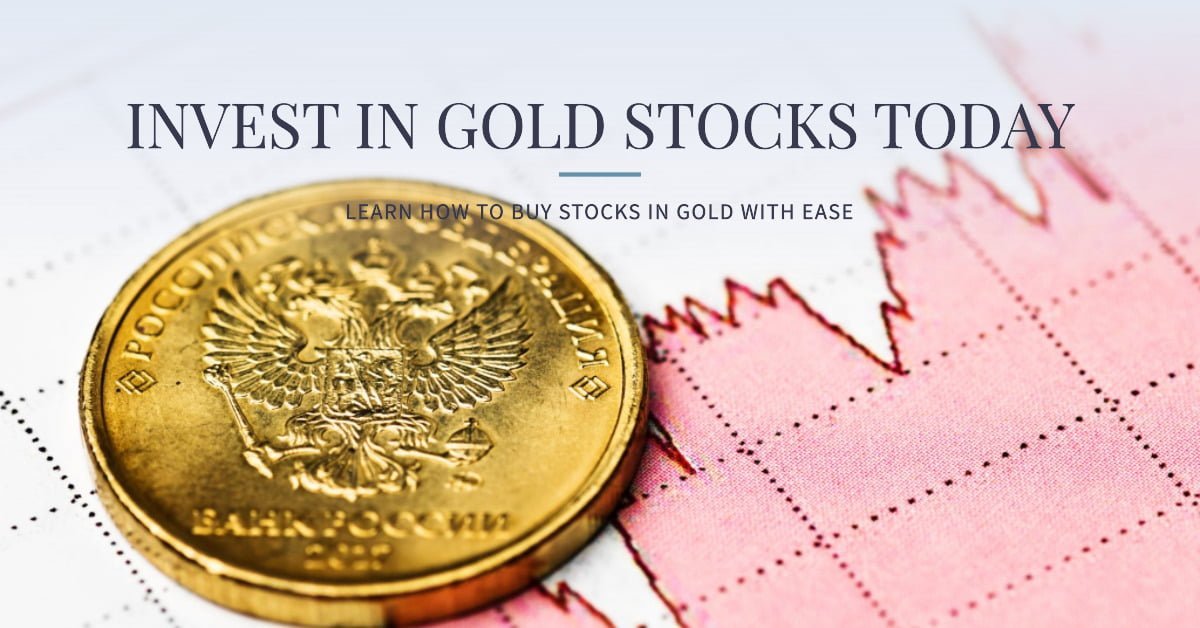Investing in gold is a great way to diversify your portfolio and protect your wealth.
But for those who are new to investing, the process of buying stocks in gold can be a bit daunting.
In this guide, we’ll walk you through the steps of buying gold stocks or funds, explain the differences between buying physical gold and investing in gold companies, and provide tips on how to get started.
Key Takeaways
💰 Understanding Gold Stocks and Funds: Gold stocks and funds are investments in companies that mine, refine, and trade gold, allowing investors to gain exposure to gold prices without owning the physical metal.
🖥️ How to Buy Gold Stocks and Funds: To invest in gold stocks or funds, one needs a brokerage account. After choosing an online broker, you can search for the gold stock or fund, select the number of shares, and click “Buy”.
⚖️ Benefits and Risks: Gold stocks and funds offer diversification and potential high returns but come with risks like market volatility, company-specific challenges, and broker fees.
⛏️ Investing in Gold Miners: Investing directly in gold mining companies requires research on the company’s financial health, management team, and performance history before purchasing their stock.
🥇 Buying Physical Gold: Types of physical gold include gold bars, coins, and jewelry. It’s crucial to buy from reputable dealers, be aware of the current gold price, and securely store the purchased gold. Risks include market volatility, storage costs, and counterfeit products.
Understanding Gold Stocks and Funds
Before we dive into how to buy gold stocks and funds, let’s first understand what they are. Gold stocks and funds are investments in companies that mine, refine, and trade gold.
Investments in gold stocks or funds are commonly perceived as a strategic approach to tap into the value of gold without the necessity of possessing the actual metal. When you choose to purchase a gold stock or fund, you’re not just buying a mere share; you are placing your faith and capital in the prosperity and growth of the respective company or even multiple companies involved in the gold industry.
This method allows investors to potentially benefit from the fluctuations in gold prices, all while diversifying their portfolios.
How to Buy Gold Stocks and Funds
In order to buy a gold stock or fund, you’ll need a brokerage account, which you can open with an online broker. There are many online brokers available, so it’s important to do your research and find one that fits your needs.
Once you’ve chosen a broker, follow these steps to buy gold stocks or funds:
- Log in to your brokerage account
- Search for the gold stock or fund you want to buy
- Select the number of shares you want to purchase
- Click “Buy”
It’s essential to recognize that every brokerage can have its own distinct set of fees and stipulations. As such, it’s crucial to diligently review and understand the terms and conditions associated with each one.
This ensures that you’re fully aware of any potential costs or requirements before you finalize any transaction or make a purchase. Being informed in this manner can help you avoid any unwelcome surprises down the line.
Benefits and Risks of Investing in Gold Stocks and Funds
Similar to various other investment avenues, gold stocks and funds offer their own set of advantages and challenges. While they present promising opportunities for growth and diversification, they also carry inherent risks that investors need to be aware of and consider carefully.
Here are some of the most important things to consider:
Benefits
- Diversification: Investing in gold stocks and funds can help diversify your portfolio and reduce risk.
- High potential returns: Gold stocks and funds have the potential to deliver high returns if the price of gold goes up.
- Easy to buy: With online brokers, it’s easy to buy and sell gold stocks and funds.
Risks
- Market volatility: The price of gold can be volatile, which means that the value of your investment may fluctuate.
- Company-specific risks: Investing in individual gold companies can be risky, as the success of the company is tied to many factors outside of your control.
- Fees: Online brokers may charge fees for buying and selling gold stocks and funds.
How to Invest in Gold Miners
Investing in gold miners is another way to gain exposure to the price of gold. This involves investing in companies that mine, refine, and trade gold.
While it may seem like a straightforward proposition, there are still important things to consider when investing in gold miners.
Here are some steps to get started:
- Research gold mining companies: Look for companies that have a strong track record of success and are financially stable.
- Look at the company’s financials: Look at the company’s balance sheet, income statement, and cash flow statement to get a better understanding of its financial health.
- Evaluate the company’s management team: Look at the experience and track record of the company’s management team.
- Invest in the company: Once you’ve done your research and evaluated the company, you can invest in the company’s stock.
Buying Physical Gold
Acquiring physical gold, whether in the form of coins, bars, or bullion, is not only a tangible asset but also an excellent strategy to diversify your financial portfolio. This diversification provides an added layer of protection for your wealth, especially in turbulent economic times.
But before you dive in, it’s important to understand the basics of buying physical gold.
Types of Physical Gold
There are a few different types of physical gold you can buy, including:
- Gold Bars
Also known as bullion, gold bars are a popular choice for those looking to buy physical gold. They are typically sold by the gram or ounce and can vary in purity, weight, and manufacturer. It’s important to research reputable dealers and check the bars’ purity, form, size, and weight before making a purchase [1]. - Gold Coins
Another popular option for buying physical gold is gold coins. These coins are often minted by government mints and can come in different sizes and denominations. It’s important to research the coins’ authenticity and rarity before making a purchase. - Gold Jewelry
Gold jewelry can also be a form of physical gold. However, it’s important to note that jewelry often has additional costs associated with it, such as design and craftsmanship fees, which can make it a less cost-effective option for investing in gold.
How to Buy Physical Gold
Once you’ve decided on the type of physical gold you want to buy, there are a few steps you can take to make your purchase:
- Research Dealers: It’s important to research reputable dealers and compare prices before making a purchase. Look for dealers that have been in business for a long time and have good reviews.
- Check the Price of Gold: The price of gold can fluctuate daily, so it’s important to check the current price before making a purchase.
- Buy from a Reputable Dealer: When buying physical gold, it’s important to buy from a reputable dealer to ensure that you’re getting a genuine product. Look for dealers that have a good reputation and offer warranties or guarantees.
- Store Your Gold Securely: Once you’ve bought your physical gold, it’s important to store it securely. Consider storing it in a safe or a safety deposit box.
Risks of Buying Physical Gold
While buying physical gold can be a great way to diversify your portfolio, it’s important to understand the risks involved.
Here are a few risks to consider:
- Market Volatility: The price of gold can be volatile, which means that the value of your investment may fluctuate.
- Storage and Insurance Costs: Storing physical gold securely can come with additional costs, such as the cost of a safe or a safety deposit box. Additionally, you may want to consider purchasing insurance to protect your investment.
- Counterfeit Products: It’s important to buy physical gold from a reputable dealer to ensure that you’re getting a genuine product. Counterfeit products can be a problem in the gold market [3].
Conclusion
As we wrap up this comprehensive guide on how to buy stocks in gold, it’s important to provide a conclusion that summarizes the key takeaways and leaves readers with actionable steps they can take.
First and foremost, investing in gold can be a great way to diversify your portfolio and protect your wealth. Whether you choose to buy physical gold or invest in gold stocks and funds, it’s important to do your research and choose a reputable broker or dealer.
In addition, it’s important to understand the risks involved in investing in gold, such as market volatility and potential storage and insurance costs. By taking these risks into consideration and managing your portfolio carefully, you can make informed decisions about investing in this exciting market.
One key takeaway from this guide is the importance of doing your research and understanding the different ways to invest in gold. By taking the time to learn about the market and choose the right investment options for your needs, you can make smart choices and achieve your financial goals.
Overall, investing in gold can be a complex and exciting process, but by following the tips and information provided in this guide, you can make informed decisions and build a strong portfolio.
Remember to do your research, choose reputable brokers and dealers, and manage your portfolio carefully to achieve success in the world of gold investing.
In conclusion, we hope that this comprehensive guide on how to buy stocks in gold has been helpful and informative for you. Whether you’re a seasoned investor or just starting out, we believe that the information provided here can help you make smart choices and achieve your financial goals.
So take the time to research and understand the market, and remember to always manage your investments carefully. With these tips and strategies, you can invest in gold with confidence and achieve success in the exciting world of precious metals investing.
FAQs About How to Buy Stocks in Gold
For those who are venturing into the world of gold stocks or funds for the first time, it’s natural to have a plethora of questions and uncertainties.
Ensuring clarity and understanding is paramount before diving into this exciting investment avenue.
Disclaimer
The information provided on this website and any related content is for informational purposes only and should not be considered as financial advice. It is not intended to substitute professional financial advice, nor does it constitute a recommendation to buy, sell, or invest in any financial product or asset.
All investment decisions and actions taken by individuals based on the information provided are at their own risk. Before making any financial decisions, individuals should consult with a qualified financial advisor or professional to assess their unique financial situation, risk tolerance, and investment goals.








